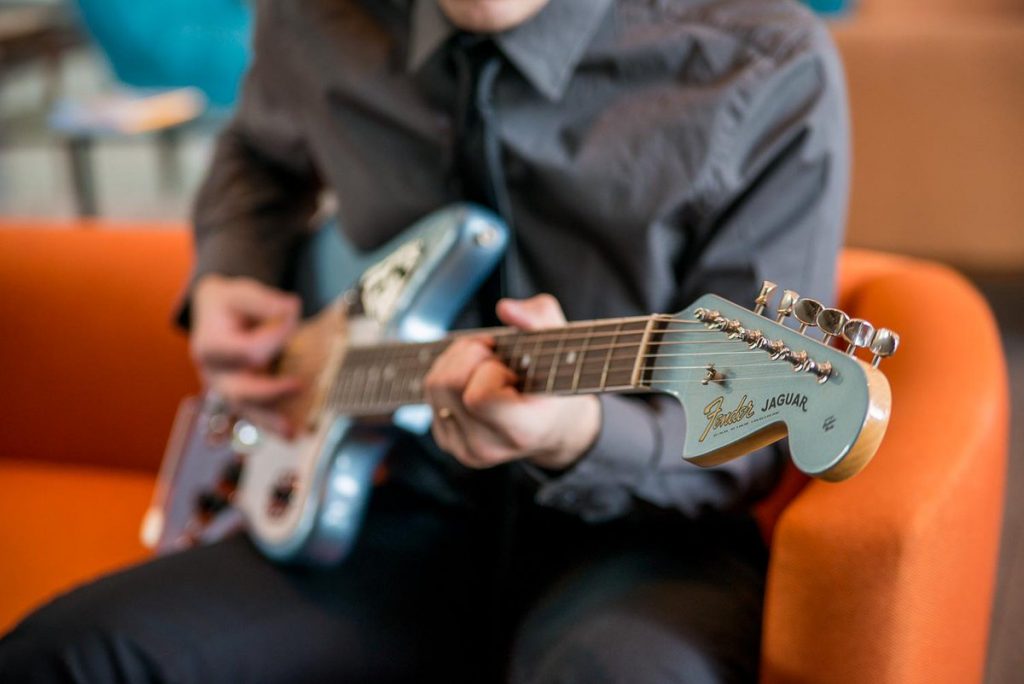Large hands with long fingers are common physical traits found amongst some of the best guitar players. Just do a quick Google search and look at the hands of Paul Gilbert, Buckethead, John Mayer, Guthri Govan, Eric Clapton, Stevie Ray Vaughan, Jimi Hendrix, and Wes Montgomery. Having bigger hands definitely gives you an advantage when it comes to playing complex chord voicings, reaching for large interval jumps, and playing fast licks.
However, many guitar legends like Angus Young and Prince didn’t have massive digits, and just look at how they’ve transformed how we play the guitar forever. You can also spend a few minutes on Instagram watching tiny 8-year-olds shred on the guitar as if they’ve been playing for decades. If you apply the following tips, it is definitely possible to become a great guitarist despite having small hands.
Stretch
Just like athletes stretch to improve their flexibility, musicians should stretch regularly too. In fact, problems often arise due to a lack of flexibility rather than a lack of finger length. Stretching also helps you warm up your hands before you play, which can help you avoid any potential injuries related to playing guitar.

Begin all of your practice sessions with a simple stretching routine. You can begin by massaging your hands and forearms, then proceed to stretch your wrists and each finger. Remember to stretch your fingers in different directions. Check out this video from GuitarLessons365 to get a good idea of how you should perform these stretches. The most important thing to remember when performing these stretches is they should not be painful! Do these exercises slowly and gently.
Use your pinky finger
This may sound like a strange tip, but I can’t count the number of times I’ve encountered guitarists that avoid using their pinky finger. If you have large hands, it’s easy to get away with not using your pinky as you can always stretch your ring finger to fret those notes; but if you have small hands, you’re going to have to get used to using all your fingers.
Certain chords will also be much easier to play if you use your pinky finger instead of your ring finger. For example, check out this Am9 chord.
Pay attention to your thumb
This tip will help you avoid injuring your thumb when playing guitar. As much as possible, you want to avoid putting your thumb over the neck, like you’re gripping a baseball bat. Instead, you want to keep your thumb behind the neck as much as possible. Generally having your thumb around the middle of the neck works well.
This rule is often broken, especially if you like to fret notes with your thumb like John Mayer or Jimi Hendrix, but having smaller hands will mean that you’ll want to avoid doing this too much as it causes a lot of tension on your thumb and wrist.
Practice
At the end of the day, any physical limitations you may encounter can be overcome if you spend a lot of time practicing. The hours you spend practicing will reveal different methods to work around obstacles and you may even end up with your own unique way of playing guitar.

Even if you’re unsure of what to practice initially, just forcing yourself to sit down and practice random things will eventually reveal the things you need to work on and the things you’ve already nailed down. To sum it up, when in doubt, practice.
Use a capo
There is an odd opinion amongst some guitarists that using a capo is equivalent to “cheating” and it’s a clear sign of a lack of skill. This can not be farther from the truth. Put simply, there are countless legitimate reasons for using a capo. Feel free to check out our previous article on how to use a capo to get an idea of why you may need to use one.
For guitarists with smaller hands, a capo is an essential tool as it can help you avoid playing too many barre chords. While it is important to know how to use your barre chords, these chords tend to put a lot of tension on your fretting hand, especially if you have smaller hands. The use of a capo and a good understanding of how to transpose keys can help you minimize the number of barre chords used in a song.
Consider buying a ¾ size guitar
There are a ton of ¾ or “travel” sized guitars currently on the market and they are perfect for people with smaller hands. Popular models include the Little Martin, Ed Sheeran’s signature Martin, the Baby and Big Baby Taylor, and Fender’s Travel acoustic guitars.
As the name implies, ¾ sized acoustic guitars are simply that — a guitar that is ¾ the size of regular sized acoustics. The great thing about these guitars is that they usually come with a shorter neck length which will allow you to stretch across different frets easier. They’re also really light and compact which makes them really portable.
In terms of sound quality, many of these ¾ sized guitars stack up really well to their full-size counterparts. In fact, many of these smaller guitars sound so good that you can see them being used regularly by touring musicians. Do a quick search of Ed Sheeran’s live performances and you will see that he often performs with his Little Martin acoustic guitar.
Scale length and neck profile
When it comes to electric guitar, two things to consider if you have smaller hands is the guitar’s scale length and neck profile. Let’s talk about the scale length first. A guitar’s scale length is the distance between the nut and the bridge, and different guitars use different scale lengths. For example, most Gibson guitars use a scale length of 24.75 inches while most Fenders use 25.5 inches. How this translates into the fretboard is that guitars with shorter scale lengths have smaller frets, resulting in a fretboard that is easier to stretch your fingers across. A shorter scale length also allows you to perform string bends with ease as there is less tension in the strings. If stretching across different frets is a problem for you, you’ll definitely want to go with a guitar with a shorter scale length.

In order to measure the scale length of your own guitar, you can either find the specifications of your guitar online, or you can measure the distance between the nut and the 12th fret and multiply that number by two. For example, my Fender Telecaster has a distance of 12.75 inches from the nut to the 12th fret, and if I multiply that number by two, I will get 25.5 inches. The reason why we don’t measure straight from the nut to the bridge is because if you look at the string saddles on the bridge, every saddle has a slightly different position. If you’re curious about the different scale lengths of different guitars, most manufacturers provide their specifications online.



